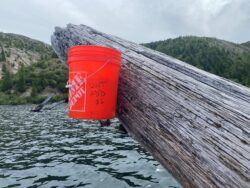By Heaven Denham, University of Washington Tacoma, Environmental Sciences
Heaven and Hailey Germeau, of the University of Washington, Tacoma, received WALPA’s 2022 Undergraduate Scholarship
Previous research in 2018 by James E. Gawel, Charles M. Crisafulli, and Rich Miller measured a complete nutrient budget for Spirit Lake but found an imbalance in inputs versus outputs of nitrogen and phosphorus, with outputs being greater than inputs. The only factors that were not measured were the dry and wet deposition inputs; instead, regional estimated data was used to calculate the deposition input of total N and P over five months. We wanted to find out if there was a significant input of total N and P from dry deposition to explain the imbalance. As the disturbed landscape surrounding Spirit Lake is subject to greater-than-average movement of pollen, soil, and insects, we hypothesized that dry deposition may be much higher than average regional values and may significantly contribute to nutrient inputs to Spirit Lake.
For our setup, we were quite lucky that Spirit Lake is inundated with logs from the 1980’s eruption, so there was a plethora of logs embedded in the lake sediment for us to use. We came up with the idea of drilling five-gallon buckets into the logs and placing a smaller two-gallon bucket inside each larger one to collect the deposition. Over the course of three months, collecting the deposition each month, we were able to analyze our samples.
Overall, we found that the estimated input of total N was underestimated based on the previous estimate of 1,937 kg per five months versus the quantified measurement of 3,262.56 kg per five months. We also found the estimated input of total P was overestimated based on the previous estimate of 133 kg per five months versus the quantified measurement of 115.32 kg per five months. Quantifying the dry deposition and refining the nutrient budget will now help us better understand how revegetation, further disturbance from climate change, or usage of the Monument will affect the lake in the future.









